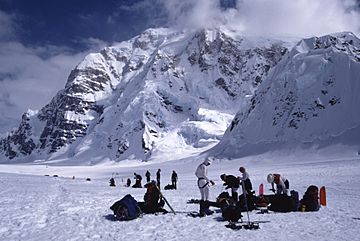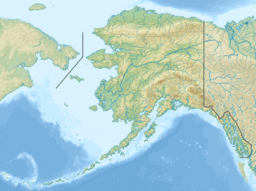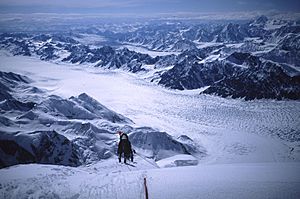Mount Hunter (Alaska) facts for kids
Quick facts for kids Mount Hunter |
|
|---|---|
| Begguya | |

Mt. Hunter from the northwest (Kahilta Base Camp)
|
|
| Highest point | |
| Elevation | 14,573 ft (4,442 m) NAVD88 |
| Prominence | 4,653 ft (1,418 m) |
| Isolation | 6.88 mi (11.07 km) |
| Listing |
|
| Geography | |
| Location | Matanuska-Susitna Borough, Alaska, U.S. |
| Parent range | Alaska Range |
| Topo map | USGS Talkeetna D-3 |
| Climbing | |
| First ascent | 1954 by Fred Beckey, Heinrich Harrer, Henry Meybohm |
| Easiest route | serious snow/ice/rock climb (Alaska Grade 4, 5.8, AI 3) |
Mount Hunter is a tall mountain in Denali National Park in Alaska. It is also known as Begguya, which means "Denali's Child" in the Dena'ina language. This name makes sense because Mount Hunter is about 8 miles (13 km) south of Denali, the highest peak in North America.
Mount Hunter is the third-highest main peak in the Alaska Range. It has a unique shape, with a large, flat glacier at its top. This glacier connects the North (Main) Summit and the South Summit, which is about 13,965 feet (4,257 meters) high. The mountain also has long, sharp ridges and very steep sides.
Contents
How Mount Hunter Got Its Name
The original name for this mountain is Begguya, given by the native people of the area. It means "Denali's Child."
In the early 1900s, some people called it Mount Roosevelt. In 1903, a reporter named Robert Dunn visited the area. He was with Frederick Cook, who was trying to climb Mount McKinley (now called Denali). Dunn named a nearby tall mountain after his aunt, Anna Falconnet Hunter, who helped pay for his trip. However, he actually named a different peak, now known as Kahiltna Dome. A government surveyor made a mistake in 1906 and accidentally put the name "Hunter" on the mountain we know today as Mount Hunter.
In October 2010, the South Summit of Mount Hunter was given a new name: Mount Stevens. This was done to honor Ted Stevens (1923–2010), who was a very important senator from Alaska for many years.
Climbing Mount Hunter
Even though Mount Hunter is not as tall as Denali, it is actually a much harder mountain to climb. This is because of its very steep sides and sharp, icy ridges. Fewer climbers attempt Mount Hunter compared to its larger neighbor.
The first people to successfully climb Mount Hunter were Fred Beckey, Heinrich Harrer, and Henry Meybohm. They reached the top in 1954 by climbing the long West Ridge. This was a big achievement for their time. They used special climbing techniques, like front-pointing with their crampons, which were quite new back then.
Since 1977, the northwest face of Mount Hunter has become famous for very difficult climbs. Many expert climbers have tested their skills on its steep rock and ice.
Famous Climbs on Mount Hunter
Here are some of the notable climbs on Mount Hunter:
- 1954 West Ridge - This was the very first time anyone climbed to the top of Mount Hunter. It was done by Fred Beckey, Heinrich Harrer, and Henry Meybohm.
- 1977 Lowe-Kennedy - This route was climbed on the north face.
- 1979 South Spur - John Mallon Waterman climbed this route by himself. It took him 145 days!
- 1981 Moonflower Buttress - Mugs Stump and Paul Aubry made the first climb up to the last rock band on this route.
- 1983 Moonflower Buttress - Todd Bibler and Doug Klewin completed the first full climb of this route all the way to the summit.
- 1985 Diamond Arete - Jack Tackle and Jim Donini made the first climb on this route.
- 1989 Northwest Face - Conrad Anker and Seth 'S.T.' Shaw completed the first climb on this face on July 3, 1989.
- 1994 Deprivation - Scott Backes and Mark Francis Twight made the first climb on this very challenging route.
- 1994 Wall of Shadows - Greg Child and Michael Kennedy completed the first climb on this route.
Images for kids




